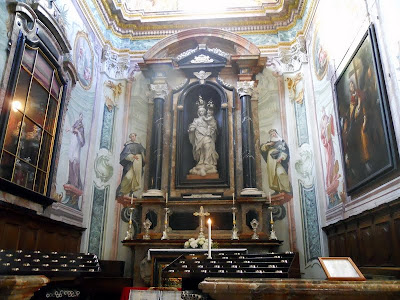Leaving the chapels at the Sacro Monte of Orta, which was added to the World Heritage List in 2003, we noticed a groundskeeper, thoroughly absorbed in his hedge-clipping. He was protected from the horrendous noise by his headphones. We were not.
Fortunately, the noise diminished as we began our descent, passing by villas clustered along the lakeside, and entered the lovely little town of Orta San Giulio.
Before proceeding to the large lakeside square, the Piazza Motta, we stopped to visit the little church of Santa Maria Assunta, a lovely golden-sided structure that dates from the 15th century when it was built to consecrate the end of a plague epidemic. The inside, originally decorated in baroque style, was beautifully redecorated in the 18th century.
One reason that it has become a favorite venue for weddings is because of the view of Lake Orta from its steps.
From there, we continued our descent to Piazza Motta and the lakefront, where we boarded a ferry for the Isola San Giulio.
San Giulio, also known as Saint Julius of Novara, was a missionary priest to northern Italy in the 4th century. Few facts are known about his life. He may originally have been Greek and educated in the Christian faith by his parents. According to legend, he was ordered to destroy pagan altars and sacred woods and to build Christian churches. Also according to legend, he walked on his cloak across Lake Orta to the island that now bears his name. He is said to have built 100 churches and the 100th is located on the island.
The Basilica de San Giulio, established in 390 AD, has had its interior redecorated since then. Like many of the Sacro Monte chapels and Santa Maria Assunta, it has baroque features, including an enormous serpentine pulpit carved from dark green marble mined from a nearby quarry. As we had already learned from our time in Stresa, quarries abound in these mountainous areas.
We also strolled around the island via the path of silence.
The path of silence received its name from an order of Benedictines who took vows of silence. We were respectful but not necessarily silent as we toured the narrow streets,
and viewed the decorated houses
and sculptured fountains.
Beauty was everywhere, from simple geraniums adding bright emphasis to weathered stones
to vividly blue hydrangeas
to a fellow traveller, posing unaware as she herself attempted to capture the moment.















No comments:
Post a Comment